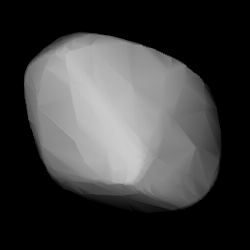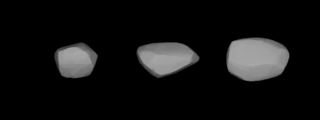
Alkeste is a main-belt asteroid, and it is an S-type (silicaceous) in composition. C.H.F. Peters discovered the asteroid on August 23, 1872, from the observatory at Hamilton College, New York State. The name was chosen by Adelinde Weiss, wife of the astronomer Edmund Weiss, and refers to Alcestis, a woman in Greek mythology.

Ismene is a very large main belt asteroid. It was discovered by German-American astronomer C. H. F. Peters on September 22, 1878, in Clinton, New York, and named after Ismene, the sister of Antigone in Greek mythology.

Carolina is a sizeable Main belt asteroid. It was discovered by Austrian astronomer Johann Palisa on 28 November 1883 in Vienna, and was named after Caroline Island, now part of Kiribati in the Pacific Ocean. This asteroid is orbiting the Sun at a distance of 2.88 AU with a period of 4.89 yr and an eccentricity (ovalness) of 0.06. The orbital plane is tilted at an angle of 9.0° to the plane of the ecliptic.

Prymno is a somewhat large Main belt asteroid. It is classified as a B-type asteroid and probably has a primitive composition not unlike common C-type carbonaceous asteroids.

Atropos is a typical Main belt asteroid that was discovered by Austrian astronomer Johann Palisa on 8 March 1888 in Vienna.

Bavaria is a carbonaceous background asteroid from the intermediate asteroid belt, approximately 54 kilometers. It was discovered by Johann Palisa on 16 November 1890 in Vienna.

Siri is a main belt asteroid in orbit around the Sun. It was discovered by German astronomer Max Wolf on 19 March 1892 in Heidelberg. The origin of this asteroid's name is unclear. On October 5, 2092, 332 Siri will pass 4,981,670 km (3,095,470 mi) from the asteroid 29 Amphitrite with a relative velocity of 2.054 kilometers per second.
Padua is a main belt asteroid that was discovered by Auguste Charlois on 17 March 1893 in Nice. It was named after the city of Padua, near Venice, Italy.

Burgundia is a typical main belt asteroid that was discovered by Auguste Charlois on 18 September 1893 in Nice. It was named for the former French region of Burgundy. It is one of seven of Charlois's discoveries that was expressly named by the Astromomisches Rechen-Institut.

Persephone is a main belt asteroid. It was discovered by German astronomer Max Wolf on 23 February 1895 in Heidelberg.

Arsinoë, minor planet designation 404 Arsinoë, is a large main-belt asteroid. It is classified as a C-type asteroid and is probably composed of carbonaceous material.
Elisabetha is a large main belt asteroid that was discovered by German astronomer Max Wolf on 7 January 1896 in Heidelberg. It may have been named after his mother, Elise Wolf.
Emita is a minor planet orbiting the Sun that was discovered by the Italian astronomer Luigi Carnera on February 12, 1902. The meaning of the asteroid's proper name remains unknown.
Suleika is a minor planet orbiting the Sun. Previously designated as 1905 QK, it was discovered by German astronomer Paul Götz on 6 April 1905 from Heidelberg, Germany.

Rebekka is a minor planet orbiting the Sun, which was discovered on September 19, 1905, by a German astronomer Paul Götz in Heidelberg. It was named after a young lady from Heidelberg, and may have been inspired by the asteroid's provisional designation 1905 RB.
Sidonia is a minor planet orbiting the Sun that was discovered by the German astronomer August Kopff on November 3, 1905. It was named after a character in Christoph Willibald Gluck's opera Armide. The name may have been inspired by the asteroid's provisional designation 1905 SD.
Tekmessa is a minor planet orbiting the Sun that was discovered by American astronomer Joel Hastings Metcalf on February 16, 1906. The name may have been inspired by the asteroid's provisional designation 1906 TK.

665 Sabine is a minor planet orbiting the Sun that was discovered by German astronomer Wilhelm Lorenz on July 22, 1908.

708 Raphaela is a minor planet orbiting the Sun.
947 Monterosa is a minor planet orbiting the Sun.













